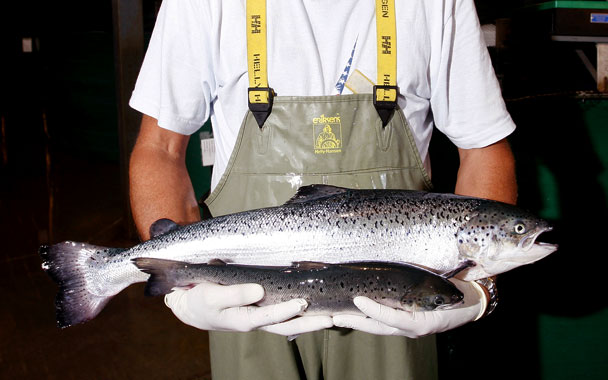One of the scariest encounters I have ever had occurred a half-dozen years ago in Prince Edward Island, the famously quaint province with neat, white farmhouses, well-tended fields, and sweeping shoreline vistas around every bend. There, across the road from a wharf stacked high with lobster traps, I was buzzed through a security door into a laboratory belonging to Aqua Bounty Technologies, a Massachusetts-based biotechnology firm that specializes in the genetic engineering of marine animals.
A geneticist led me into a dim, warehouse-like space that seemed to be filled with above-ground children’s swimming pools. I peered into one. It was filled with young Atlantic salmon the size of cigarettes. The one beside it held much larger fish, easily as big as Churchill cigars. The eggs that hatched into both groups had been fertilized on the same day. The fish had eaten the same food. The only difference was that the larger creatures had received genes from another species, the ocean pout, that made them produce massive amounts of a growth hormone—meaning they grow to market size faster (like the fish on top in the above photograph).
There’s a chance that Aqua Bounty’s genetically modified (GM) fish will arrive at a supermarket near you within the next year—without a label indicating that you are about to serve your family GM seafood.
Last week the Food and Drug Administration took a giant step toward allowing the meat of GM animals into the nation’s food supply when it released a draft of regulations for producers of GM livestock and lab animals. The draft is open for a 60-day comment period.
If you care to tell the FDA what you think, follow this handy link provided by the Center for Food Safety.
Despite concerns expressed by consumer groups and environmentalists, it appears that it’s full steam ahead at the FDA. Randall Lutter, the agency’s deputy commissioner for policy, gushed excitedly that engineered animals “hold great promise,” adding, “Our guidance provides a framework for both GE animals and products made from them to reach the market.”
Bernadette Dunham, the FDA’s head veterinarian, gave assurances that the technology would have “real benefits” for both animal and human health.
Is there a trend here? It was only a month ago that the FDA greenlighted the controversial practice of irradiating spinach and lettuce. If only the FDA had applied this kind of energy to keeping our food supply safe over the past year.




 Pinterest
Pinterest


